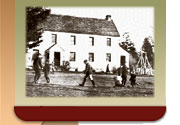







|

| |
GRADE 5 LESSON PLAN
Introducing The Cariboo Gold Rush
This lesson provides a general historical overview of the locales, main events, major participants, and central social and political issues involved in the Cariboo Gold Rush.
Prescribed Learning Outcomes
Grade 5 Social Studies
Applications of Social Studies
It is expected that students will:
- identify and clarify a problem, issue, or inquiry
- gather and record a body of information from a variety of primary and secondary sources
- develop alternative interpretations from varied sources
- defend a position on a regional issue in light of alternative perspectives
Society and Culture
It is expected that students will:
- demonstrate understanding of Canadian culture
- explain ways people preserve and transmit culture
- demonstrate appreciation of contributions of Aboriginal peoples, the French, and the British to the development of Canada
- demonstrate understanding of why immigrants come to Canada, the challenges they face, and their contributions to Canada
Politics and Law
It is expected that students will:
- explain citizenship in terms of participation in the community, province, country, and world
- demonstrate awareness of the history of Aboriginal peoples' rights
Economy and Technology
It is expected that students will:
- analyse the relationship between development of communities and their available natural resources
- explain how supply and demand are affected by population and the availability of resources
Environment
It is expected that students will:
- locate and describe major physical features of Canada using topographic and thematic maps
- demonstrate understanding of sustainability, stewardship, and renewable versus non-renewable natural resources
- assess effects of lifestyles and industries on local and global environments
Grade 5 English Language Arts
Comprehend and Respond (Strategies and Skills)
It is expected that students will:
- read, listen, and view for specific purposes
- use strategies, including developing questions, rereading, reading further, and reviewing, to clarify meaning and build understanding
Comprehend and Respond (Comprehension)
It is expected that students will:
- demonstrate understanding of the main ideas or events in print (including stories and poetry) and in non-print media
- use a variety of written and graphic forms, including charts, webs, and maps, to organize details and information
- describe information contained in simple and direct illustrations, maps, charts, or other graphic representations
Organization & Scheduling
Suggested time: 2-3 hours
Materials & Resources
- student resource: The Cariboo Goldrush Adventure Game Website: Map of Routes to British Columbia, 1862
- student handout: Voices from the Past: Barkerville Cemetery
- student handout: What the Voices Tell
- teacher resource: Introduction to the Cariboo Gold Rush
- teacher resource: Reading Barkerville Cemetery
- teacher resource: on cemeteries as documentary evidence to construct social history, see sites such as collections.ic.gc.ca/tombstone/
Suggested Procedure
- Introduce students to the main themes of the Cariboo Gold Rush. This general overview might focus on the event's locales, its chronology, and main participants, with some notice to the social, economic, and political aspects of this event in the development of British Columbia during the 1860s. The teacher resource Introduction to the Cariboo Gold Rush may prove helpful, and it may be useful to copy and distribute to students the Map of Routes to British Columbia, 1862 in The Cariboo Goldrush Adventure Game to anchor the introduction.
- Ask student to "travel" to the Cariboo gold fields by playing The Cariboo Goldrush Adventure Game, which provides an interactive overview of the history of and participants in the Cariboo Gold Rush.
- After students have finished playing The Cariboo Goldrush Adventure Game, debrief the information it provides by asking them to identify the main events, listing these on a chalkboard or on poster paper as ideas come and afterwards placing them in rough chronological order. Sample responses might include:
- discovery of gold in the Cariboo
- publicizing news of the discovery
- influx into British Columbia of migrants of diverse national origins
- travel to the Cariboo gold fields
- establishment of mining towns (e.g., Barkerville and Yale)
- The students' interactive experience with The Cariboo Goldrush Adventure Game and the establishment of a Cariboo Gold Rush chronology should allow introducing possible topics for discussion. Some of these might include:
- nature and role of transportation technology (e.g., steamboat, stagecoach)
- establishment of mining towns (e.g., Barkerville and Yale)
- infrastructure improvements (e.g,, the Cariboo Wagon Road)
- secondary economic opportunities (e.g., trade and merchant activity, providing transportation and accommodation, banking)
- immigration and sources of migrants
- interaction with the Aboriginal peoples
Some of the topics form the focus of other lessons but can be introduced here with in-depth follow-up coming later.
- After the class has identified the chronology and main themes of the Cariboo Gold Rush, continue to debrief the information in The Cariboo Goldrush Adventure Game with a general overview of the human stories behind the discovery of gold in the Cariboo. Topics might include:
- who went there and why
- how they travelled to the gold fields
- what they saw or heard about during their travels
- what they did there
- whom they travelled with
- whom they met on arriving in the Cariboo
- interesting things that happened to them and new impressions they had
- whether they returned to their home countries after the gold rush.
- After students have identified the participants and have a sense of their experiences during the Cariboo Gold Rush, continue to debrief the information in The Cariboo Goldrush Adventure Game with a general overview of the roles that European and Aboriginal women, in particular, played in the event. Roles that students identify might include:
- wives of miners: both European and Aboriginal
- boardinghouse keepers
- shopkeepers
- laundry workers
- entertainers (Hurdy Gurdy Girls)
- supplies packers: both European and Aboriginal women
- providers for the sick and injured: both European and Aboriginal women
- Make and distribute copies of the student handout Voices from the Past: Barkerville Cemetery and the worksheet What the Voices Tell. Explain that history relies on various kinds of evidence, both written and physical, and that social history, the history of people's daily lives, is often not found in official records but in artefacts and "documents" such at the headstones in Barkerville Cemetery.
- After students have completed the worksheet What the Voices Tell, ask them to describe their discoveries.
- As a follow-up exercise to the activity What the Voices Tell, have students locate in conventional or online sources the original places from which Barkerville's inhabitants came. Ask them to create a world map showing these places with flags or other markers.
Possible Assessment
Adaptations
- The reading level of some of the resources and the acquisition of new vocabulary may offer challenges to ESL students and students with reading difficulties. Contextual support may be required.
Extensions
- Classes in areas with easy access to the actual Cariboo Gold Rush historic sites would ideally arrange to visit heritage locations and museums. See the Attractions section of The Cariboo Goldrush Adventure Game for information . Preparation prior to the excursion is necessary and debriefing should follow it. Alternatively, have students "travel" to the modern-day towns of Barkerville and Yale in conventional and/or on-line sources to discover how the Cariboo Gold Rush is remembered (e.g., museums, preserved buildings, and historic sites).
- Have students work in pairs to explore one of the first-hand accounts (e.g., letters, journals) of the Cariboo Gold Rush in the Primary Sources section of The Cariboo Goldrush Adventure Game and The Cariboo Gold Rush (http://www.tbc.gov.bc.ca/culture/schoolnet/cariboo/. The pairs can report back to the entire class a summary of what they read to give a sense of the variety of experiences the Cariboo Gold Rush occasioned.
- Have students create a timeline of the Cariboo Gold Rush in poster form, relying on data from conventional or online sources. The timeline might be accompanied by illustrative material (e.g., maps, photographs, drawings) reproduced from the The Cariboo Goldrush Adventure Game or from other sources. (The Cariboo Gold Rush (http://www.tbc.gov.bc.ca/culture/schoolnet/cariboo/.)
- Have students research how historians "do" history by using written and/or physical evidence. Ask students to discover online sources for the "raw" history of the Cariboo Gold Rush (e.g., British Columbia Archives, Gold Rush town sites) and to report on these to the entire class.
|
|



